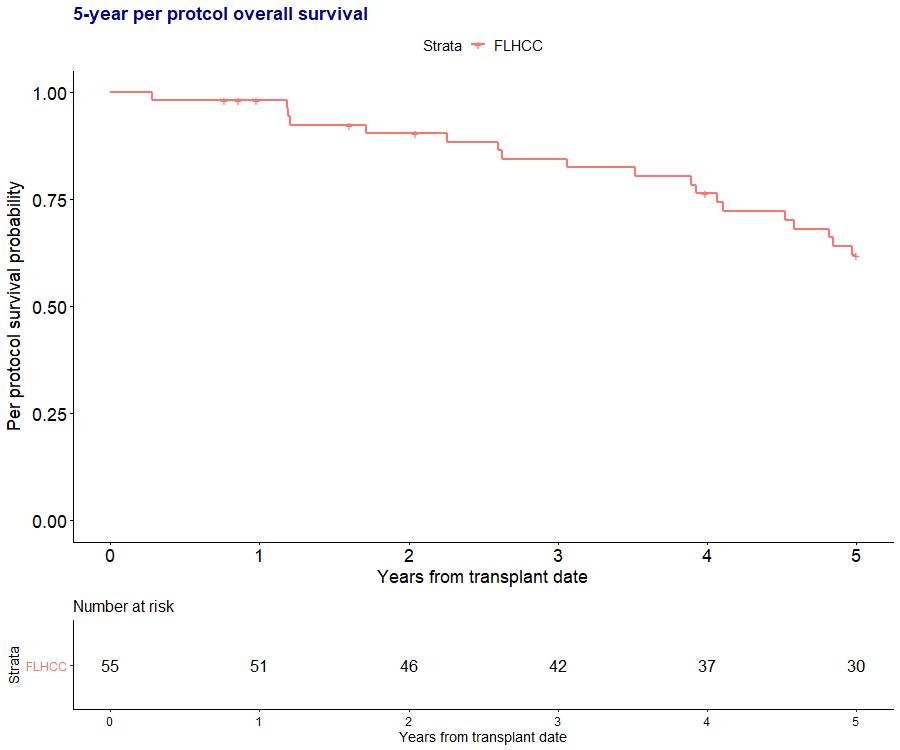Liver Transplantation for Patients with Fibrolamellar Hepatocellular Carcinoma: A Comprehensive Multicenter Analysis to Support Future Decision Making
1Multi-Organ Transplant Program, University Health Network, Toronto, ON, Canada, 2HPB and Transplant Surgery, Erasmus MC, Rotterdam, Netherlands
Meeting: 2022 American Transplant Congress
Abstract number: 1097
Keywords: Hepatocellular carcinoma, Liver transplantation, Malignancy, Surgery
Topic: Clinical Science » Liver » 56 - Liver: Hepatocellular Carcinoma and Other Malignancies
Session Information
Session Name: Liver: Hepatocellular Carcinoma and Other Malignancies
Session Type: Poster Abstract
Date: Sunday, June 5, 2022
Session Time: 7:00pm-8:00pm
 Presentation Time: 7:00pm-8:00pm
Presentation Time: 7:00pm-8:00pm
Location: Hynes Halls C & D
*Purpose: Fibrolamellar hepatocellular carcinoma (FL-HCC) is a rare tumour accounting for ~1% of all primary liver cancers. Due to its rarity, there is a shortage of data on liver transplantation (LT) for patients with FL-HCC. To gain more insight on the management of these patients, we conducted a comprehensive multicenter analysis of FL-HCC patients looking at both post-listing and post-LT outcomes.
*Methods: Patients diagnosed with FL-HCC and listed for LT or transplanted between 1987-2019 were extracted from the UNOS registry. Re-LT and multi-organ transplants were excluded. Outcomes were waitlist (WL) dropout and ITT overall survival (OS), derived from all patients with a FL-HCC diagnosis at listing, and post-transplant OS, recurrence-free survival (RFS), cumulative incidence of recurrence, and 30-/90-day post-transplant mortality, for all patients with a confirmed FL-HCC diagnosis at explant pathology. WL dropout was defined as dropping out of the WL due to death, clinical deterioration, or medical unsuitability. Median follow-up times were 4.5 years (interquartile range [IQR] 1.2-8.2) from listing and 5.0 years (IQR 2.6-9.8) post-LT.
*Results: A total of 96 unique patients with a diagnosis of FL-HCC at listing or post-LT were extracted. Of these, 53% were female and 76% adult, with a median age of 25.5 years (range 10-66). Cirrhosis was present in 10 patients (10%) and 8 patients had an underlying disease (8%): hepatitis C virus (5), non-alcoholic steatohepatitis (2), glycogen storage disease (1). Of all FL-HCC patients, 72 were diagnosed at listing (75%), 10 post-LT (10.5%), and of 14 the moment of diagnosis was unknown (14.6%). Sixty-nine patients received a LT, of which 55 were post-operatively confirmed of having FL-HCC. Eight patients received a living donor LT. WL dropout at 1- and 2-years post-listing was 15.3% and 19.4%. ITT OS at 1, 3, 5 years was 86.5%, 67.9%, 55.5%, where post-LT OS was 98.2%, 84.4%, 61.9% at 1, 3, 5 years. RFS was 85.3%, 69.9%, and 47.5% at 1, 3, and 5 years. The cumulative incidence of recurrence at 1, 3, 5 years was 12.8%, 24.4%, and 44.7%. There was no statistical difference in all outcomes between adult and pediatric patients.
*Conclusions: LT for FL-HCC patients offers acceptable long-term survival outcomes despite a substantial risk of recurrence. Further research is needed to determine which patients with FL-HCC would benefit most from LT and potential adjuvant therapies to reduce the risk of recurrence.
To cite this abstract in AMA style:
Claasen MP, Ivanics T, Polak WG, IJzermans JN, Sapisochin G. Liver Transplantation for Patients with Fibrolamellar Hepatocellular Carcinoma: A Comprehensive Multicenter Analysis to Support Future Decision Making [abstract]. Am J Transplant. 2022; 22 (suppl 3). https://atcmeetingabstracts.com/abstract/liver-transplantation-for-patients-with-fibrolamellar-hepatocellular-carcinoma-a-comprehensive-multicenter-analysis-to-support-future-decision-making/. Accessed December 26, 2025.« Back to 2022 American Transplant Congress

